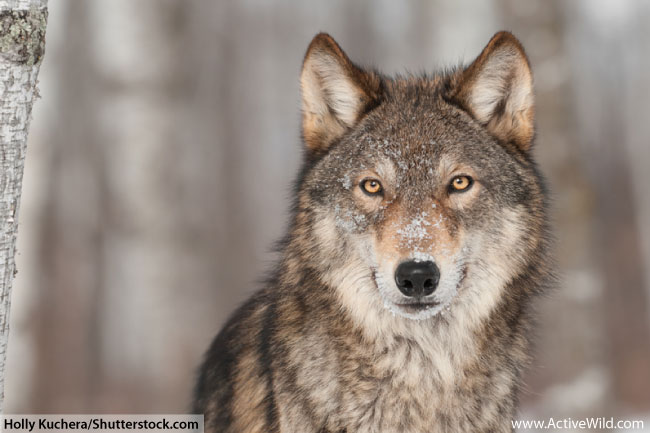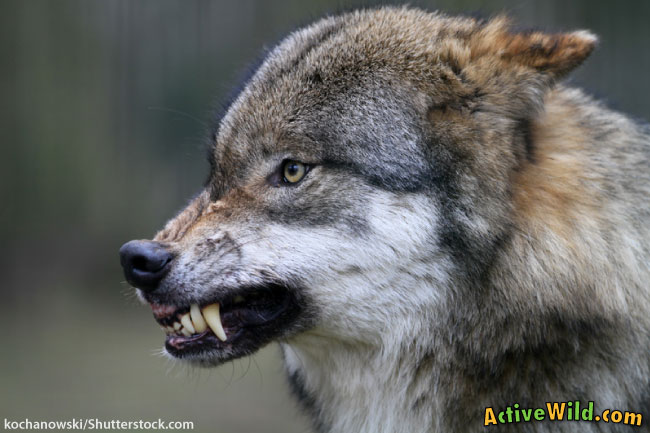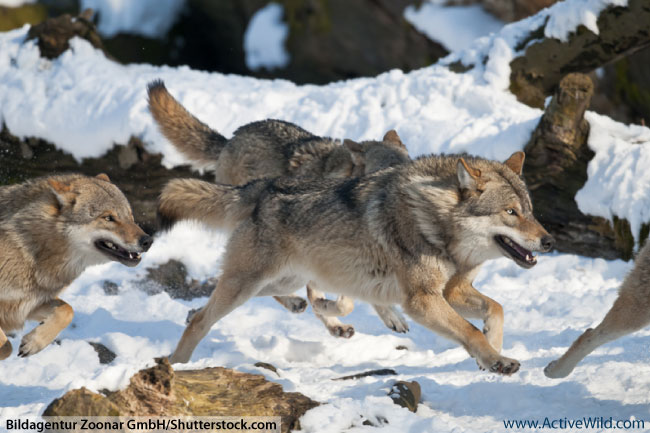This page contains amazing Eurasian Wolf facts for kids (and adults). This animal is part of the Active Wild Online Zoo: information, pictures and videos of all your favorite animals!
Eurasian Wolf Quick Facts
- Other Name(s): common wolf, middle Russian forest wolf
- Scientific name: Canis lupus lupus
- Type of Animal: Mammal, member of the Carnivora order
- Animal Family: Canidae (Dog family)
- Where Found: Northern Europe, Russia
- Length: 1 to 1.6m (3.3 to 5.2ft.)
- Height: 0.85m (2.8ft.) shoulder height
- Weight: average weight 40kg (88lb)
- Conservation Status: Least Concern
Eurasian Wolf Video
Watch the video below to see Eurasian wolves in the wild:
The Eurasian Wolf: Introduction
From the ‘big bad wolf’ in Little Red Riding Hood to the legendary ‘werewolf’, the wolf – or gray wolf to give it its full name – is the subject of myths and fairytales in many parts of the world.
The Eurasian wolf is one of the 37 recognized subspecies (types) of gray wolf. All 37 subspecies are essentially the same animal; the Eurasian wolf could have pups with any of the other grey wolf subspecies, which include the Arctic wolf, the dingo … and the domestic dog.
Most wolf subspecies live in separate areas in the wild, and have slight physical variations that reflect the different conditions in which they live.
The Eurasian wolf is one of the largest wolf subspecies, and the largest type of wolf found outside of the Americas.
Where Does The Eurasian Wolf Live?
Wolves have been driven out of many parts of Europe and are now only found in remote areas, far away from towns and cities. Despite this, the Eurasian wolf has the largest range (the area in which it is found in the wild) of any type of wolf.
Small, isolated groups are found in western European countries and Scandinavia. Larger wolf populations are present in Eastern European countries such as Poland and Romania. By far the largest number of Eurasian wolves – perhaps as many as 30,000 – live in Russia.
Eurasian wolves are still hunted in many countries, but are increasingly protected by local laws.
How To Recognize A Eurasian Wolf
The Eurasian wolf has a pale gray-brown coat, which is lighter on the undersides and darker on the back and shoulders.
Apart from size, the physical differences between wolf subspecies are often small. The Eurasian wolf has a slightly narrower head and longer ears than its North American cousins. The Eurasian wolf’s howl is longer and more varied in tone than those of the North American subspecies.
Life In A Wolf Pack
Wolves are social animals and live in family groups called packs. A typical wolf pack consists of an alpha pair and 3 to 9 of their offspring. Larger wolf packs comprise two or more of these families, and can number up to 30 or more animals.
A pack hunts within its own territory. Territories vary in size from around 130 km2 (50 sq. miles) to over 1,000 km2 (386 sq. miles). Wolves mark their territory with scent, and warn off other packs by howling.
Wolves will fight to defend their territories. Territorial fights are the leading natural cause of wolf deaths in the wild.
Wolves mate for life. Young wolves stay with the pack for between 1 and 4 years, before leaving to establish their own territories.
Why Do Wolves Howl?
The wolf communicates in a number of ways, including body language, scent, and vocalizations such as growling, barking and whining.
However, the sound most commonly associated with the wolf is its eerie, prolonged howl. Wolves howl to bring their own pack together, and to warn rival packs to stay away.
Are Eurasian Wolves Endangered?
The wolf’s IUCN Red List conservation status is ‘Least Concern’, and the world’s wolf population is stable. However, wolves used to be present in many more parts of Europe than they are now, and wolves are highly dependent on the areas that they do inhabit remaining undeveloped.
Eurasian Wolf Facts For Kids: Questions
Q1. What animal family is the Eurasian wolf a member of?
- a) The Canidae, or dog family.
- b) The Felidae, or cat family.
- c) The Carnivora order.
Q2. Which country has the largest number of Eurasian wolves?
- a) England
- b) Poland
- c) Russia
Q3. How many wolf subspecies are currently recognized?
- a) 37
- b) 7
- c) 1
Now see more amazing animals in the Active Wild Online Zoo!
Visit a world-class zoo ... without leaving your home! At the Active Wild Online Zoo you'll find FREE pictures, facts and information on the world's most incredible animals. Each page also features a specially chosen video, and a list of questions to test your knowledge!
See other animals in the online zoo now!
Eurasian Wolf Facts For Kids: Answers
Q1) a, Q2) c, Q3) a






Thank you for the info! I really need it for the book I am writing!